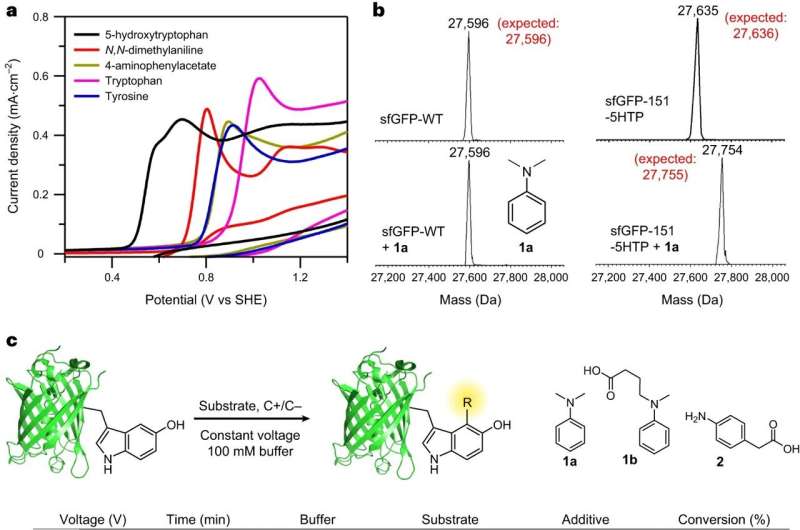This article has been reviewed according to Science X's editorial process and policies. Editors have highlighted the following attributes while ensuring the content's credibility:
fact-checked
trusted source
proofread
Researchers use electrocatalysis for site-specific protein modification

Boston College researchers used a mild charge of electricity to precisely modify proteins, a new tool that can be used to develop novel biotherapeutics and protein-based research tools, the team reported recently in the journal Nature Chemistry.
The team, led by BC professors of chemistry Abhishek Chatterjee and Eranthie Weerapana, developed and optimized a novel electrochemical protein labeling reaction called "eCLIC" that enables precise modification of site-specifically incorporated 5-hydroxytryptophan (5HTP) residues on many different proteins including full-length therapeutic antibodies.
"We used this strategy to generate many site-specific protein conjugates, including an antibody-cytotoxic drug conjugate that selectively enters and kills cancer cells, but not non-cancer cells," said Chatterjee. "A key advantage of eCLIC is the reagents needed for this method are really inexpensive, costing less than $10 a gram."
The team's success marked the first time electrocatalysis has been used to achieve protein modification in a site-specific manner, they reported in their article "Electrochemical labeling of hydroxyindoles with chemoselectivity for site-specific protein bioconjugation."
Proteins are large molecules, typically composed of hundreds of amino acid monomers, Chatterjee noted. The ability to selectively modify proteins at predefined sites is important for many applications. For example, by covalently attaching toxic drugs to antibodies it has been possible to selectively deliver them to cancer cells, which resulted in both improved therapeutic efficacy and reduced off-target toxicity.
Many research applications also require the attachment of biophysical probes onto various proteins. The ability to define the site of modification on proteins is critical to ensure that important protein functions are not harmed, Chatterjee said.
"The challenge arises from the fact that all proteins are made from 20 amino acids in various combinations," he said. "Identifying a modifiable functionality at the desired site, not repeated elsewhere, is typically challenging, which makes it difficult to achieve site-specificity in protein modification."
To overcome these challenges, the team sought to develop a method to incorporate a non-natural amino acid at any chosen site(s) of a protein. The team accomplished this by reengineering the translation system of cells to accommodate the new amino acid 5HTP.
In addition, the researchers wanted to design chemical reactions that could be used to selectively modify this nonnatural amino acid in the presence of all of the natural amino acids, Chatterjee said.
"If we could do this, we could provide a general method to generate proteins with a built-in 'attachment-handle' at a predefined site. In particular, we were interested in developing a reaction that would use electricity to catalyze the protein modification reaction instead of chemical catalysis since the former is inexpensive, environmentally friendly, and gentle on delicate proteins."
Chatterjee said the team was able to overcome an unusual challenge when they first tried to model the reaction. Typically, researchers start with small molecules, in this case, 5HTP and aniline, then move on to large proteins.
But first attempts at the reaction between 5HTP and anilines at the small-molecule level were messy, as the 5HTP molecules reacted preferentially with each other. But when 5HTP was incorporated into a large protein, it was no longer able to react with another protein-bound 5HTP and cleanly reacted with an aniline instead, the team reported.
"If we had stuck with the traditional progression—from small to large—we'd have never pursued eCLIC, thinking 'it's too messy'," Chatterjee said. "Instead, we did our reaction development non-traditionally, directly on a protein, which helped us realize how clean and selective it was in this setting."
To further advance the eCLIC strategy for large-scale modification of important protein targets, this technology has been licensed toBrickBio, Inc., which Chatterjee co-founded. Future research will focus on developing next-generation, site-specifically modified protein-based biotherapeutics and research reagents.
More information: Conor Loynd et al, Electrochemical labelling of hydroxyindoles with chemoselectivity for site-specific protein bioconjugation, Nature Chemistry (2023). DOI: 10.1038/s41557-023-01375-y
Provided by Boston College





















